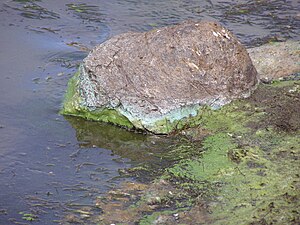
Back سم عصبي Arabic Нейратаксін Byelorussian Невротоксин Bulgarian Neurotoxin Czech Nervengift German Νευροτοξίνη Greek Neŭrotoksino Esperanto Neurotoxina Spanish Neurotoxina Basque نوروتوکسین Persian

Neurotoxins are toxins that are destructive to nerve tissue (causing neurotoxicity).[3] Neurotoxins are an extensive class of exogenous chemical neurological insults[4] that can adversely affect function in both developing and mature nervous tissue.[5] The term can also be used to classify endogenous compounds, which, when abnormally contacted, can prove neurologically toxic.[4] Though neurotoxins are often neurologically destructive, their ability to specifically target neural components is important in the study of nervous systems.[6] Common examples of neurotoxins include lead,[7] ethanol (drinking alcohol),[8] glutamate,[9] nitric oxide,[10] botulinum toxin (e.g. Botox),[11] tetanus toxin,[12] and tetrodotoxin.[6] Some substances such as nitric oxide and glutamate are in fact essential for proper function of the body and only exert neurotoxic effects at excessive concentrations.
Neurotoxins inhibit neuron control over ion concentrations across the cell membrane,[6] or communication between neurons across a synapse.[13] Local pathology of neurotoxin exposure often includes neuron excitotoxicity or apoptosis[14] but can also include glial cell damage.[15] Macroscopic manifestations of neurotoxin exposure can include widespread central nervous system damage such as intellectual disability,[5] persistent memory impairments,[16] epilepsy, and dementia.[17] Additionally, neurotoxin-mediated peripheral nervous system damage such as neuropathy or myopathy is common. Support has been shown for a number of treatments aimed at attenuating neurotoxin-mediated injury, such as antioxidant[8] and antitoxin[18] administration.
- ^ Sivonen, K (1999). "Toxins produced by cyanobacteria". Vesitalous. 5: 11–18.
- ^ Scottish Government Blue-Green Algae (Cyanobacteria) in Inland Waters: Assessment and Control of Risks to Public Health Retrieved 15 December 2011.
- ^ Dorland's Medical Dictionary for Health Consumers
- ^ a b Spencer 2000
- ^ a b Olney 2002
- ^ a b c Cite error: The named reference
Kiernan2005was invoked but never defined (see the help page). - ^ Lidsky 2003
- ^ a b Heaton; Barrow, Marieta; Mitchell, J. Jean; Paiva, Michael (2000). "Amelioration of Ethanol-Induced Neurotoxicity in the Neonatal Rat Central Nervous System by Antioxidant Therapy". Alcoholism: Clinical and Experimental Research. 24 (4): 512–18. doi:10.1111/j.1530-0277.2000.tb02019.x. PMID 10798588.
- ^ Choi 1987
- ^ Zhang 1994
- ^ Rosales, Raymond L.; Arimura, Kimiyoshi; Takenaga, Satoshi; Osame, Mitsuhiro (1996). "Extrafusal and Intrafusal Muscle Effects in Experimental Botulinum Toxin-A Injection". Muscle & Nerve. 19 (4): 488–96. doi:10.1002/(sici)1097-4598(199604)19:4<488::aid-mus9>3.0.co;2-8. PMID 8622728. S2CID 20849034.
- ^ Simpson 1986
- ^ Arnon 2001
- ^ Dikranian 2001
- ^ Deng 2003
- ^ Jevtovic-Todorovic 2003
- ^ Nadler 1978
- ^ Thyagarajan 2009
© MMXXIII Rich X Search. We shall prevail. All rights reserved. Rich X Search